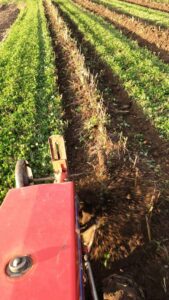Final report for FNE18-903
Project Information
This project was aimed at reducing or eliminating field flooding on the 45 ft. X 100 ft. subfields that we use for vegetable plantings on our 100 acre certified organic farm through the use of “wicking Hills”. Heavy rain events over the past few years have flooded the fields (figure 1) resulting in lost crops, soil degradation and excessive farm run-off. These fields were domed in the center to help drainage and were planted in rows of vegetables spaced approximately 3 feet apart with tilled soil between the rows.

In the new design, rows of vegetables were planted on approximately 1 ft. high hills containing wicking materials and were spaced 6 feet apart with cover crops planted between the rows. The new design would, we hoped, would drain the crop rows during heavy rains and moisten the crops from groundwater between the rows during dry spells.
In the year of the test we were fortunate to have both extremely dry months and also months with record soaking rains. The wicking hills significantly improved crop performance (figure 1b) during both extremely wet and dry months over our previous dirt field approach which was used as a control in the project. Soil quality analysis showed higher nutrient availability, closer to neutral pH, and higher organic matter in the wicking fields versus the flat fields. In terms of comprehensive soil assessment differences, the wicking hills had a score of 84 (optimal) versus 72 (excellent) in the flat field. Soil respiration differences were marked with wicking hills having a value of 0.7 and the flat field a value of 0.3.
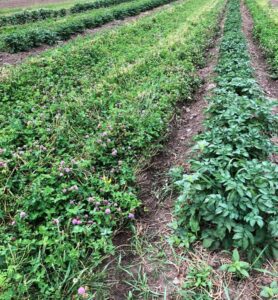
inter-row cover crops significantly
reduced flooding during wet spells
We had groups tour the farm during the tests and presented the concept at the Cornell Organic Conference followed by an article in our local “Auburn Citizen” newspaper. We are planning to expand this new field design during the next (2019) growing season.
The project objective was to design, construct and test a “wicking hill” field system for mixed vegetables that is more tolerant of very heavy rainfall and periods of extreme drought than the conventional field designs we are currently using. On our farm and throughout the northeast record rainfalls have flooded fields, saturating and compacting normally well drained organic soils (Figure 1).
Summer heat bakes the compacted soil reducing yields and leading to long term deterioration of soil life and structure. We hope to demonstrate that the wicking hills field design will result in the following improvements:
- Reduce flooding of growing area and truck/tractor paths during extreme rain periods and increase moisture level in planting areas during dry spells.
- Make planting and harvesting easier- less muddy area and looser soil for planting & weeding
- Decrease soil compaction and weeds from compacted soil areas
- Reduce run-off from our fields into stream and loss of applied nutrients
- Increase total area of cover crops on the farm
- Allow at least two consecutive season planting years on each sub-field
- Improve crop yields and quality even with the rain and heat extremes which are likely to continue
The problem which this project addressed was to find a way to deal with to the highly variable weather patterns we have seen in upstate New York and in many other agricultural areas throughout the country. In the spring of 2017 we had record rainfall (nearly three times that of 2016) flooding some of our fields, and in late summer some of the hottest, driest, hottest months. Heavy rains early caused our normally well drained organic soils to compact and subsequent hot, dry months made the compacted soil nearly impermeable. The issue is not just reduced performance in the current year, but long term deterioration of the soil structure and reduction of soil life.
Planting in our normal field design of row crops in elongated plots of about 200’ X 45’ with grass tractor paths around the plots have worked well over the past 20 years. These plots are raised in the center with drainage troughs along the sides.
Normally, the water during heavy rains would flow to the drainage ditches and to drainage tiles that run to a stream which runs along the length of the 7 to 10 acre fields that contain our planting plots. Over the past several years the rains have been heavy enough to cause flooding of both the planting area, and in some cases the tractor paths. We have concluded that the sloped fields, and drainage tiles do not respond quickly enough during heavy rains to prevent flooding, and every flood causes more soil compaction exasperating the problem.
Another factor that impacted our decision to solve the flooding problem is the nearly daily news in our local newspapers concerning the declining water quality in the New York Finger Lakes due to the growth of blue-green algae. It is believed that this problem has worsened due to extreme rain events and run-off from homes and more importantly farms that surround the lakes. Throughout the summer drinking water alerts have been posted along Owasco Lake and Skaneateles Lake. While large conventional CAFO
(Confined Animal Feeding Operations) dairy and field crop farms may be the primary sources of lake and drinking water pollution, we believe all farms, large or small, organic or conventional in the watershed area have a responsibility to deal with the heavy rain occurrences that have brought this issue to light.
Other approaches to overcome these problems, over the past 5 or so years, we and many other small scale vegetable farmers have gone from large open fields with rows of plants on bare ground using cultivators for weed control to partitioned fields incorporating tractor paths or buffer plantings to prevent soil compaction as well as water and wind erosion. Many farmers like us are using inter-crop plantings to limit soil exposure. A system we trialed on a previous SARE grant called “hybrid mulching” . In this project rows of plastic were laid in fields planted with winter rye in late September. In spring or early summer of the following year the rye is sickle bar mowed to form dense straw mulch beds between the plastic rows. Since our trial we have seen many farmers use the hybrid mulch system for vining crops such as squash or pumpkins. This system was discussed in depth in an article on our farm “Cultivating Farm Innovations” in the October 2017 addition of “Acres USA Magazine.
Another approach has been the use of raised beds, with or without plastic mulch to provide better drainage during wet periods. Each of these systems has advantages for particular crops. While conventional raised beds help by draining during wet periods, they tend to dry out during prolonged dry periods, unless artificially irrigated. On our farm the cost, labor, and environmental issues involved with field irrigation has been a problem. Plastic mulch, tubing, pumps, power, filters and the loss of water from our retention pond and wells during dry periods are the issues.
We decided that a completely new field system that naturally stores excess water during rainy periods and then uses the stored water to naturally irrigate plant rows during dry periods was needed and that "wicking hills" approach might be that system.
Cooperators
- - Technical Advisor
Research
The new field design would have to prevent or slow down water flow across the dirt sub-fields to the trenches along the field edges and into the drain tiles in the field design described in the introduction and shown in figure 2.
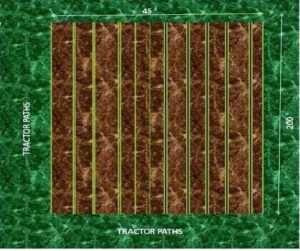
The new design would water flow breaks (hills), many more shallow drain troughs, and inter row cover crops to prevent soil exposure.
Our Wicking Hill field design a natural “irrigation system” works locally in each hilled row with excess water drained to the individual hill trenches and into the sub soil beneath and between the rows. Wicking material in the hills helps drain water out of the hills during wet periods and more importantly uses the power of capillary action to lift moisture up into the hills during dry periods, all without electrical power, plastic tubes, or other off farm inputs. Between the row trenches we propose planting a cover crop such as clover or clover mixed with other grasses or legumes to take up water that overflows the trenches.
We are currently testing cover cropping mixes for multi-year use in conjunction with Cornell Universities’ cropping systems program. In this approach, during a heavy rainfall, the total water that falls on the field would be contained by 10 trenches in the field adjacent to the wicking hills (figure 3).
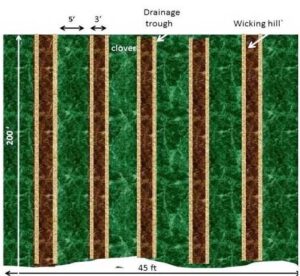
The reservoir holding the water would be in the trenches and in the subsoil just below the row trenches and hill. This water in the subsoil under the hill is replenished from the trenches following the next rainfall.
BUILDING THE WICKING HILLS
In early spring 2018 four fields were prepared as test fields for the project.
TEST FIELD #1 - MIXED CROP WICKING HILLS This field was designed as shown in figure 3. The field had been planted in May of the previous year (2017) with rows of mixed bird feed sunflowers in dense clover cover crop. The sunflowers were planted on both sides of a summer squash field and used as a trap crop for striped cucumber beetles. They were cut down in the fall of 2017 to about 6 to 8 inches above the clover tops. In April of 2018 the rows of sunflower stalks were covered with soil using a rotary plow to form the wicking hills. The sunflower stalks were the wicking material. drawing water from the subsoil and trenches along the hills into the hill tops during dry periods. The process of building the hills is shown in figure 4. The hills were filled with clover material from the inter row cover crops and each row was fertilized with Krehers 4-3-10 certified organic poultry compost/fertilizer. A short film of the rotary plow operation that moved the inter row material onto the wicking section is available here: Hill Construction Video
Figure 4 - Building The Wicking HillsThe sunflower stalks which had dried over the winter and had fairly large overlapping root systems (figure 5.) we believed would make excellent wicking material due to the veined structure of small capillary tubes.
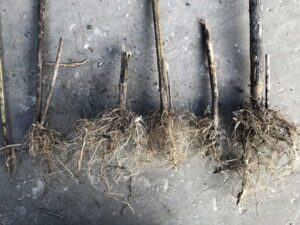
The wicking hills in this test field were planted with an assortment of vegetables, which were also planted at the same time in our normal flat field plot. Included were carrots, beets, peas, beans, tomatillos, radishes, and turnips. Some of the wicking hills were covered with black plastic, or straw, or left bare. (Figure 6). The covering (plastic or bare) on specific crops planted in the wicking hills was matched in the control flat field.
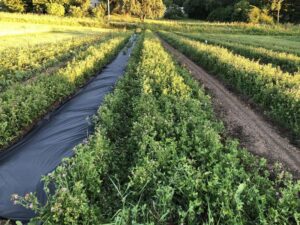
TEST FIELD #2 - CONTROL FLAT FIELD WITH MIXED CROPS AND NO HILLS OR WICKING MATERIAL
To compare test field 1 planted with mixed vegetable crops on wicking hills with our normal flat field planting method, a field was planted with the same crops on flat ground with no hills or wicking materials. The space between the planted rows was bare soil which was tilled or wheel hoed occasionally to control weeds. The crops were fertilized with the same material Krehers 4-3-10 as the other test fields. Figure 7 shows a view of this flat field early in the season. As a reminder both the onion/leek test field and the garlic test field contained both wicking hills and non-wicking hills in the same field for side by side comparison (wicking materials vs. no wicking materials) with crops we normally hill.
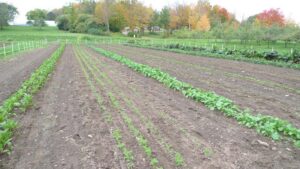
TEST FIELD # 3 - POTATO/LEEK FIELD - The second test field prepared in the spring was in a field devoted to table stock potatoes and leeks. When we plant potatoes and leeks we always hill them, again using a walk behind rotary plow or sometimes a simple single bottom plow. In this test field we wanted to compare the vigor of the potatoes and leeks when the hills included a wicking material with hills that did not for both a below soil crop and a crop grown on top of the hill. This, we thought, might help separate the benefits realized from hilling from those associated with wicking materials. In this field the wicking material selected was dry oat straw incorporated in the wicking hills. The other potato and leek hills had no wicking material. Figure 8 shows the hills prepared for planting. On the right is the place where the control plantings of potatoes and leeks would be planted on hills but without wicking material. All potatoes and leeks were planted in early May. Krehers 4-3-10 compost was incorporated in all hills.
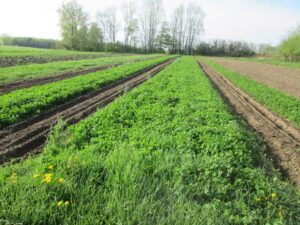
TEST FIELD #4 GARLIC FIELD-
The third field involved in the test was prepared and planted in October of 2017, the year previous to the grant project. “Music” Garlic was planted in 5 rows spaced about 6 feet apart. All the rows were planted on hills, but one row was planted in a hill containing oat straw stacked vertically and surrounded by dirt on both sides. All hills were then mulched with oat straw. (Figure 9). The purpose of this trial was to determine if the wicking material would overwinter in the soil and perhaps rob nitrogen from the soil, or cause the garlic seed to rot.
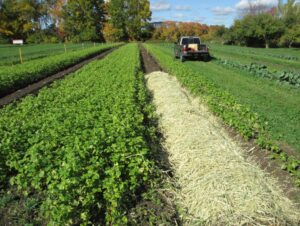
Lastly, two soil analyses were done to compare general quality and soil nutrient concentrations. Not surprisingly, the wicking hills showed more preferable numbers than the flat field. Soil quality analysis showed higher nutrient availability, closer to neutral pH, and higher organic matter in the wicking fields versus the flat fields. For example, in terms of comprehensive soil assessment differences, the wicking hills had a score of 84 (optimal) versus 72 (excellent) in the flat field. Soil respiration differences were marked with wicking hills having a value of 0.7 and the flat field a value of 0.3.
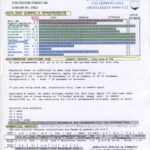
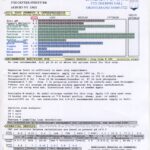
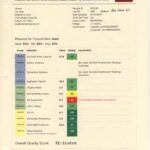
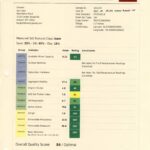
In this section we will present and discuss the results of our tests for each of our crop groups. The test overall was enhanced by the extraordinary weather we experienced in our area during the year (2018). We hoped to get some idea of the impact of the wicking hills in very dry weather and in very wet weather. We were lucky to have both extremes in a single year, record drought in April, May and June and very wet in September, October and November. The results of the trials in each of the three wicking hill test fields and in the conventional flat field follow.
MIXED CROP COMPARISON OF WICKING HILLS AND FLAT FIELDS
It was in the mixed crop fields, flat vs wicking hills, that the most dramatic differences occurred and the differences extended throughout the extreme dry and extreme parts of the season. In early June when warm weather plants such as eggplant and tomatillos were being transplanted there was a remarkable difference both observed and measured in soil moisture. Transplanting in our normal flat fields was difficult because of the extreme dryness of the soil. The soil was loose from tilling but very dry and dusty. Our relative moisture meter read 2 on a scale of 1-10. Transplants were watered every few days, but the water dissipated quickly.
Transplanting into the wicking hills was very different. The soil was more compact, still contained clover and sunflower stalk residue, and relative moisture was 8. It was remarkable that the moisture just under the soil surface on the top of the hills appeared damp during this very dry period (figure 10). In figure 10 some of the residue from sunflower stalks can be seen.
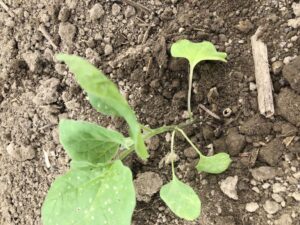
On the negative side, the soil in the wicking hills was much more compact and difficult to transplant into than in the tilled flat field. This was in part due to the higher level of moisture and to the presence of the clover residue that was incorporated into the hills when constructed a month or so earlier. The soil fertility levels in the flat field and the wicking hills were compared using the Cornell Soil Health Assessment in July. While major and minor chemical elements were similar, not surprisingly, soil respiration, organic matter and biological activity were much higher in the wicking hills than in the flat field (Rating of 94 vs 16). Throughout the dry summer and wet fall all transplants including eggplant, cabbage, tomatillos, and kale did far better in the wicking hills than on the flat test field. An example of the difference in performance of a crop which we thought might be more draught tolerant than the cole crops and therefor do equally well in both the wicking field and flat field was tomatillos. The result after 30 days from transplant is shown in figure 11. (Cages are the same height)
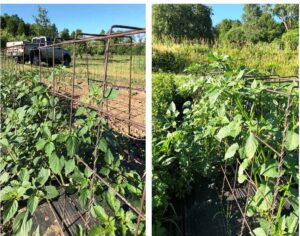
Like the transplants, direct seeded crops also did better on the wicking hills. Carrots, radishes and turnips, got off to a very slow in the dry, dusty flat field, and many did not make it in spite of regular watering. Again on the negative side direct seeding in the more compact wicking hills was difficult. It was necessary to very shallowly till the tops of the hills with a small rotary tiller to get the soil soft enough to set the seeds (Figure 11).
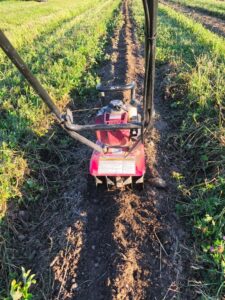
A good example of performance comparison was with the direct seeded carrots. Carrots were seeded on the wicking hills and in the flat field on the same day in mid-July, still very dry. In the flat field it took several replants to get germination, and then the germination was spotty. On the wicking hill germination was good and growth rapid. Figure 13 shows a side by side comparison.
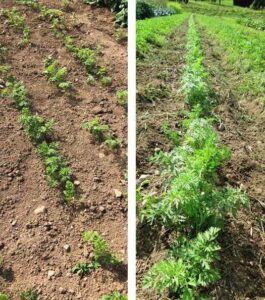
What is interesting about the carrot crop comparison is that late in the season (November) during harvest following a month of rain and snow the flat field carrots which were now a reasonable size were much harder to dig, and were rotted near the tops (Figure 14). The carrots on the wicking hills were easier to dig in moist, but not flooded, soil.
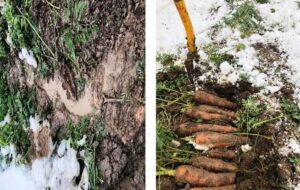
RESULTS OF POTATOES, LEEKS, AND GARLIC IN WICKING VS NON-WICKING HILLS
In order to evaluate the importance of the wicking material in the hills of normally hilled crops we compared potatoes, onions and garlic in three fields where these crops were planted on hills with and without wicking material. In these fields the wicking material was dry oat straw.
In general, the difference the wicking material made in these crop comparisons was less dramatic than in the mixed vegetable crops where the difference was a crop or no crop in some cases. The less dramatic differences in these crops was in part due to the less effectiveness of straw as a wicking material compared to sunflower stalks, and perhaps more importantly that all of these crops were planted on hills, making them less susceptible to the heavy rains we had this fall.. Having said this, there was a significant difference in the start- up rate of all these crops in the wicking hills compared to our normal hills without wicking material during the very dry spring season. For potatoes, the crop on the wicking hills was several weeks ahead of the crop on hills with no wicking material (Figure 15).
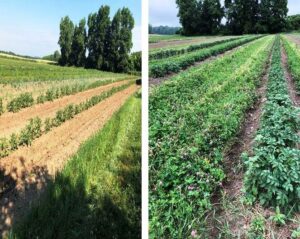
The final crops compared in the project trials were Leeks and Garlic, again normally grown on hills on our farm. As with the potatoes, we planted rows in the same field with and without wicking material which in both of these cases was oat straw. With the leeks there was some difference between the early growth rate which was quicker in the wicked hills, but by the end of the season there was no much difference. Figure 16 shows a comparison in June. You can actually see the higher moisture level in the wicking hill than on the normal hill.
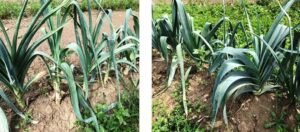
The final comparison of crops we normally grow on hills was with Music Garlic. In this case the result was opposite that with all other crops. The garlic grown on wicking hills was slightly smaller and softer that that grown on our regular hills with no wicking material. We believe this was due to the fact that the garlic was planted in October of the previous year. It may be that the wicking material, again straw, partially decomposed over the winter and early spring robbing nitrogen from the garlic clove seed and young plants.
Soil test comparison
Soil quality analysis showed higher nutrient availability, closer to neutral pH, and higher organic matter in the wicking fields versus the flat fields. In terms of comprehensive soil assessment differences, the wicking hills had a score of 84 (optimal) versus 72 (excellent) in the flat field. Soil respiration differences were marked with wicking hills having a value of 0.7 and the flat field a value of 0.3. Soil analyses results attached in section above.
The intent of this project was to try a new field design that would alleviate the crop damage to our crops and soil that have occurred due to erratic weather over the past two to three years. We tested a new field design to replace our current design of flat fields that were cultivated and planted with row crops in loose tilled soil. These fields were planted in cover crops every 2 to three years to maintain soil health. The new system tested in this project consisted of crop rows planted on hills containing wicking materials that were formed in fields of multi-year cover crops. he same acreage of cover crops each year; just distributed differently.
The weather patterns that occurred during our project year were nearly perfect from a concept evaluation standpoint, with a record dry spring and early summer followed by a very wet fall and early winter. In the very dry spring the crops planted on wicking hills prepared by covering closely spaced sunflower stalks did substantially better than the same crops on our traditional flat fields or on hills not containing wicking materials. In the wet fall season the root crops planted on the wicking hills survived rotting and were much easier to harvest. Throughout the season soil moisture levels measured on the wicking hills were near optimum!
See Rainfall Summary (inches).
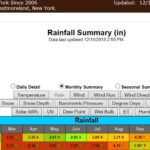
The new field design will be incorporated on our farm in new fields next season resulting in what we believe will be a significant difference in time lost to replanting flooded or dried out transplants and seeds. Even with the increase in time needed to build the hills and maintain them, the new system will, we believe, improve our farm efficiency (crop value/labor cost) by at least 25 percent.
Education & outreach activities and participation summary
Participation summary:
Outreach has been easier on this project than on others I have done due to the timely interest in climate change and the dramatic weather conditions we have experienced in the Northeast. Soon after we began the project we posted a brief description of the problem and the solution we were about to undertake in our series “From the Farmer’s Journal” which we distribute at our Country Food Store and at Our Restaurant (Figure 17)
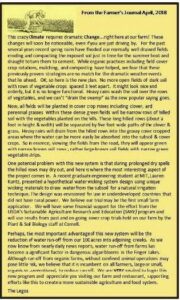
It is estimated that this short summary was read by over 8,000 people during the spring and early summer months. It stimulated comments, requested copies and resulted in follow up visits and news articles from diverse groups of farmers, Finger lakes Protection Organizations and Cornell students and professors in Environmental Science and in County Cooperative Extension, as well as the Auburn Citizen Newspaper.
In April we were invited to present the wicking hill concept at the first Organic Symposium at Cornell University. The symposium was attended by about 100 students, professors and extension agents. There were many questions about the approach we presented, and some good suggestions.
In August a group of students and professors from Cornell’s “Ecology of Agriculture” program toured the farm and at this point in the season could see the wicking hills planted around the farm. Again there were many questions and lots of interest.
Also in August, Abby Seaman and another Cornell Extension Agent visited the farm and took pictures of the wicking hill experiment as well as previous SARE Grant projects such as our spore exclusion tunnel.
On September, 11th The Auburn Citizen published a multi-page article, “Behind the Bloom”, about the role of sunflowers on our farm with focus on the role they play in our SARE sponsored wicking hill project. This article spurred interest in the local agriculture community.
In September we were invited to present a workshop on “Wicking Hills” at the 2019 NOFA Winter Conference at Saratoga Springs. This workshop will be held on January 18th.
Again, I believe the interest in our Wicking Hills project stems from a broad concern by farmers, gardeners, environmental groups, and many others on the impact the dramatic weather events are having on all of us.
Learning Outcomes
We have had a small number of actual farmers contact us about the program, and many others that we are not sure of their occupation.
Project Outcomes
This project was an eye opener to us and an avenue that we will follow to deal with climate change on our farm. We have already prepared new wicking hill fields for planting in 2019!
I believe that this project worked out very well in part due to the weather extremes we encountered in a single growing season. We definitely determined the values and costs (additional seasonal work) of the wicking hill concept. We believe it is an excellent approach for all farms to follow in order to increase productivity and reduce environmental damage due to water run-off in these times of erratic weather all over the country.

